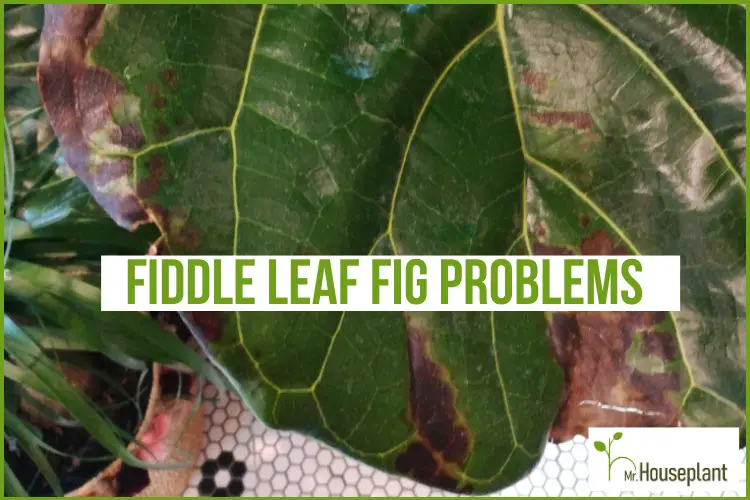
Struggling with Fiddle Leaf Fig problems? Not sure what is happening to your Ficus Lyrata? Don’t worry! This article explores the most common Fiddle Leaf Fig problems, their causes, and solutions, such as droopy leaves, curling leaves, water spots, edema, pests, and much more.
Fiddle Leaf Fig Problems
The most common Fiddle Leaf Fig problems are: droopy leaves, leaves falling off (dropping leaves), curling leaves, yellowing leaves, brown spots, not growing new leaves, water spots, edema, mushrooms, and pests.
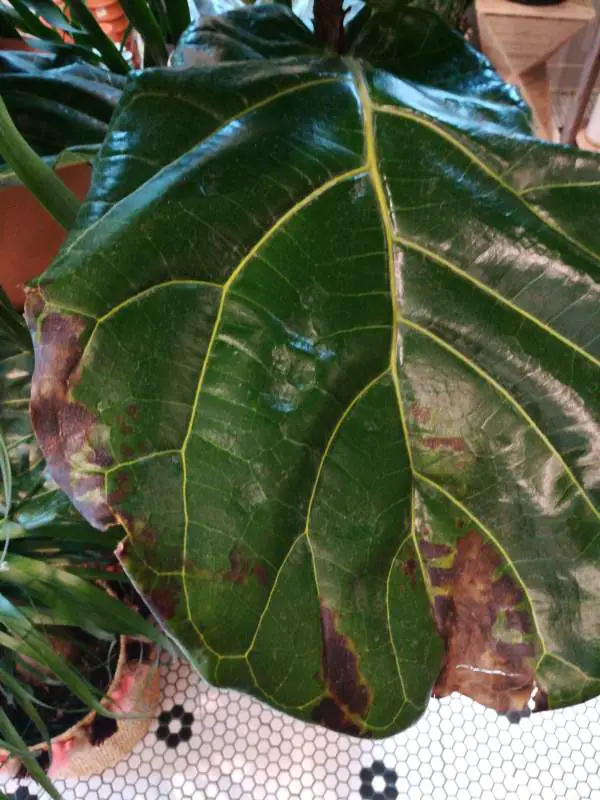
Fiddle Leaf Fig Tree leaf with brown crispy edges
Droopy Leaves
Your Fiddle Leaf Fig has droopy leaves because of improper watering, environmental change, overfertilizing or pests:
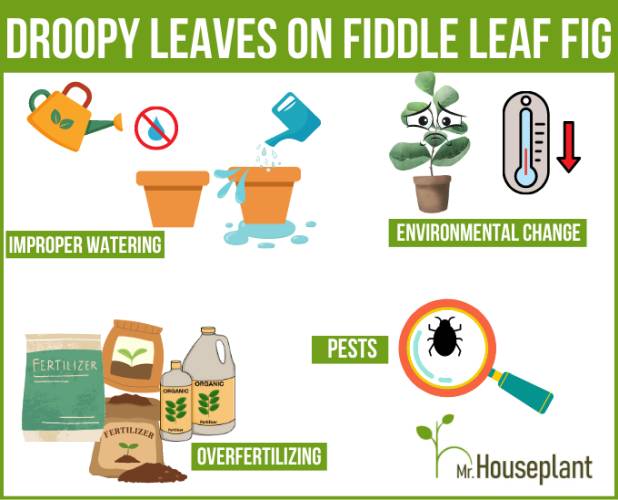
Four reasons for droopy leaves on your Ficus Lyrata
- Improper watering – Both overwatering and underwatering may cause harm. If the soil retains too much moisture (poor drainage, frequent watering, etc.), this leads to root rot. Fiddle Leaf Fig can’t absorb moisture and as a result, the plant starts to droop. With underwatering, Fiddle Leaf Fig leaf problems come from dehydration. This directly affects leaves so they become droopy. The best way to treat Fiddle Leaf Fig wilting and drooping is to adjust the watering schedule and ensure proper drainage.
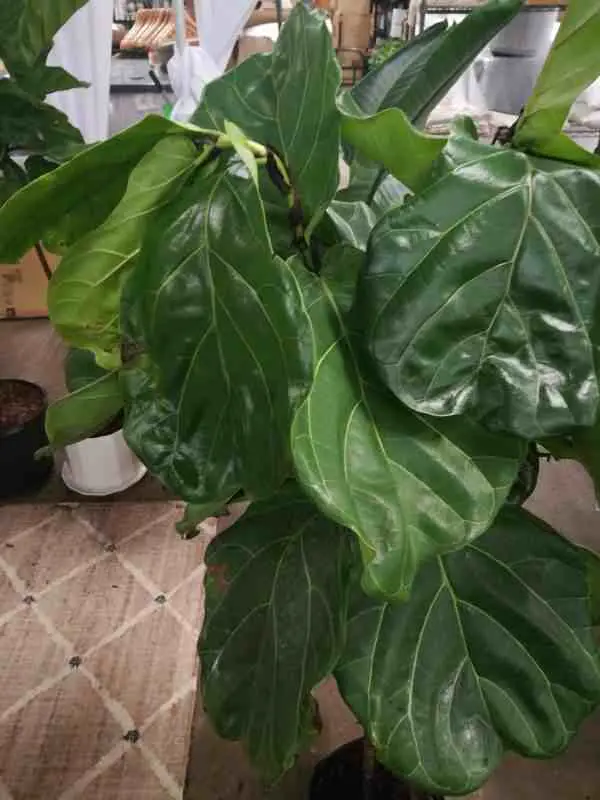
Ficus Lyrata droopy leaves caused by underwatering
- Environmental change – Fiddle Leaf Figs don’t like changes but they’re especially sensitive to temperature drops. Cold can easily make Fiddle Fig droopy. If you’ve recently moved or repotted your plant, give it some time to adjust to its new environment.
- Overfertilizing – The most serious cause of droopy Fiddle Leaf Fig is a chemical burn by a fertilizer or insecticide. If you suspect that the insecticide or fertilizer application was too strong, repot the plant into new soil immediately. Remove all soil, rinse the roots under running water and pot into new soil.
- Pests – If the younger leaves are droopy, like in the image below, and older leaves are not, you most likely have pests. Inspect the plant closely, with a magnifying glass or a macro lens. If you notice pests, treat the plant with neem oil, or insecticidal soap.
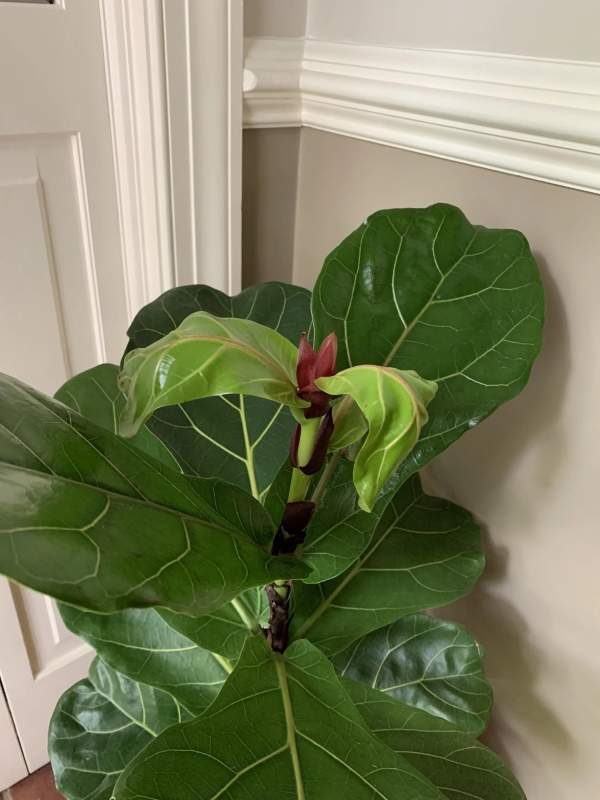
Young leaves attacked by pests can start curling
Leaves Falling Off (Dropping Leaves)
Your Fiddle Leaf Fig is dropping leaves for one of several reasons: lack of light, underwatering or overwatering.

Three reasons for dropping leaves
- Lack of light – If you move your plant from a brighter spot to a spot with less light, it can drop a few leaves, because it’s unable to support all the leaves with the amount of light in its new spot. Or if you have just brought home a new plant, it might drop a few leaves, as it will get less light in your home than it did in the nursery.
- Underwatering – Lack of moisture may cause severe Fiddle Leaf Fig leaf problems. Although Figs need good drainage, prolonged dry conditions will cause droopy leaves, which will turn into dropping leaves and can eventually kill your plant. The watering schedule will be different for each person, depending on their home environment. Water your plant as soon as the soil has completely dried out.
- Overwatering – Overwatering (too frequent watering or using too much water when watering) in combination with insufficient amount of light can lead to root rot. Root rot will cause leaves to drop. If this is the case with your plant, do a full repot. Remove all soil and repot the plant into a terracotta pot or into a better draining mix (2 parts soil, 1 part perlite) and move the plant into a spot with more light.
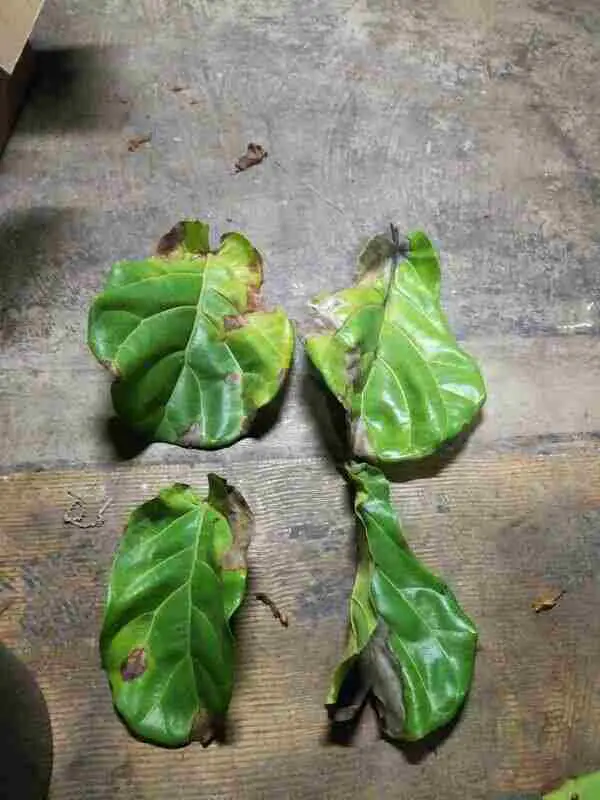
Leaf loss from underwatered Fiddle Leaf Fig
Curling Leaves
Your Fiddle Leaf Fig has curling leaves due to overwatering or underwatering or pests. Plants’ older leaves curl when roots can’t supply enough moisture to the stem and leaves. If you notice that older leaves are puckering, that’s a sign that your plant is not getting adequate moisture – either too much or not enough water. Prolonged dry conditions most certainly lead to health issues and may even kill a plant. Root rot caused by overwatering may also make leaves curl and cause severe damage, even the death of a plant. A consistent, suitable watering schedule is crucial in preventing Figs become underwatered or overwatered.
Yellowing Leaves
Fiddle Leaf Fig plant can have yellow leaves due to lack of light, improper watering, nutrient deficiency, or leaf senescence:
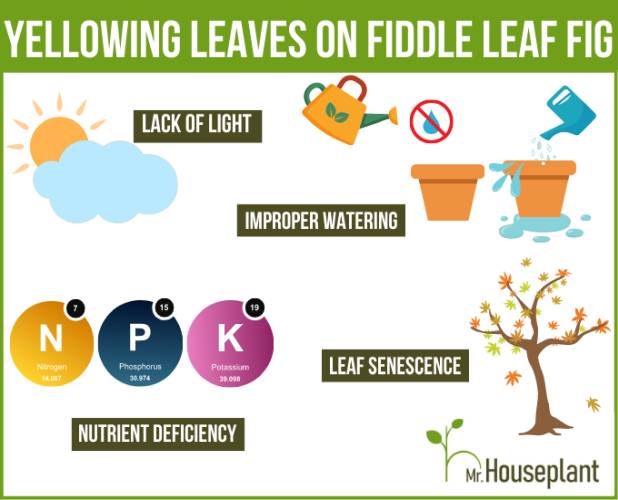
If your plant has yellow leaves, it is due to one of these four reasons
- Lack of light – Light is the most limiting factor in indoor gardening, especially when it comes to Fiddle Figs. Since they enjoy great amounts of light, plant’s leaves may turn yellow when light requirements are not met. The solution is to place your plant in front of the brightest window. If you can’t find a place for your plant to get enough natural light, consider using a pendant grow light.
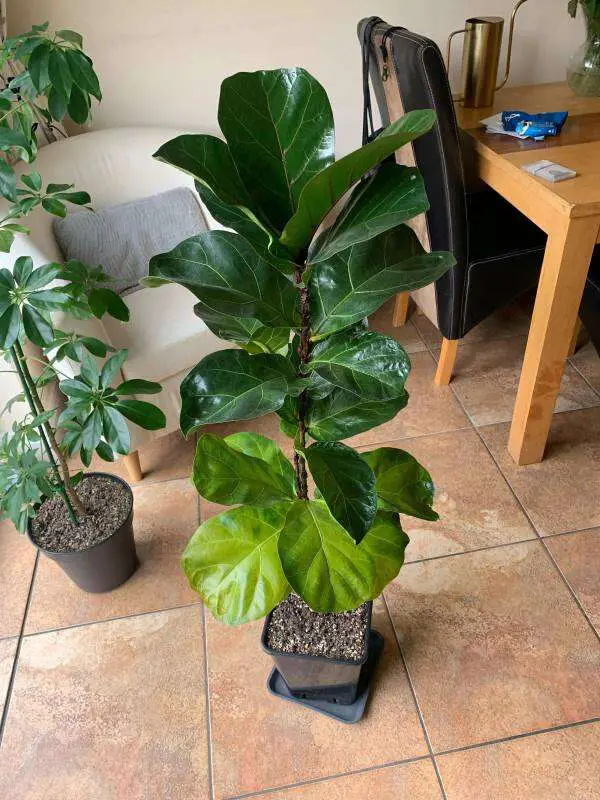
Leaves may start yellowing if there is not enough light for the plant
- Improper watering – Underwatering and overwatering lead to yellowing leaves. The exact watering frequency will depend on the environment the plant is in and will be different for each person. In general, you’ll want to let the soil dry out between waterings. To determine if it’s watering time, stick a chopstick in the soil, all the way to the bottom of the pot. Pull the chopstick out, and if it’s dry and clean it’s time to water. If it’s dirty and has soil stuck to it, hold on with watering.
You also need a porous, well-draining Fiddle Leaf Fig soil mix. A good potting mix will provide oxygen for the roots and will not let the roots sit in wet soil for too long.

Yellowing leaf on a Fiddle Leaf Fig due to underwatering
- Nutrient deficiency – Nutrient deficiency can cause different Fiddle Leaf Fig leaf problems, including yellowing leaves. In most cases, the leaves will turn yellow, while the leaf veins will remain green. If your Fiddle Leaf Fig looks like this, consider reporting to provide fresh soil rich with nutrients. Alternatively, you can fertilize it with a high-nitrogen fertilizer.
- Leaf senescence – This is a normal process where older leaves turn yellow and fall off. During this process, the plant recovers mobile nutrients from the yellowing leaves before they fall off and moves them to other parts of the plant where they can be reused.
Brown Spots
Brown spots on Fiddle Leaf Fig leaves are caused by one of several reasons: root rot, bacterial infection, dryness, pest damage, physical damage and sunburn. I will cover all of these in a separate blog post very soon.
Not Growing New Leaves
Before you get down to fixing potential issues, make sure you’re not just expecting your Fig to grow faster than it’s possible. Fiddle Leaf Figs are slow growers. You may just need to be patient and give it enough time to develop new leaves.
If your Fiddle Leaf Fig hasn’t been growing new leaves for several months, it is due to one of the following reasons:
- The plant is root bound – As the plant’s roots grow, they eventually run out of space. When this happens, roots miss out on a lot of water and nutrients available from the soil. No nutrients for the plant means no new growth. To prevent pot bound situation, repot your Fiddle Leaf Figs each year. Choose a one-size bigger container to allow space for further growth.
- Not enough light – Fiddle Leaf Figs enjoy lots of light and thrive when acclimated gradually to full sun. Low light conditions are least favorable for Fiddle Leaf Fig’s health and growth. In case your plant is not receiving enough light, it will likely lead to stunted growth. How to fix this? Move the Fig to the brightest spot in your home or use grow lights to compensate for the lack of natural light.
- Not enough nutrients – Nutrients are necessary for photosynthesis. Fiddle Leaf Figs lacking nutrients will have a hard time growing. An easy fix is to repot the plant once a year a use a potting mix that’s airy and well-draining. Annual repotting provides fresh soil and all the nutrients to your plants. Another fix is to fertilize to compensate for the lack of nutrients in the soil.
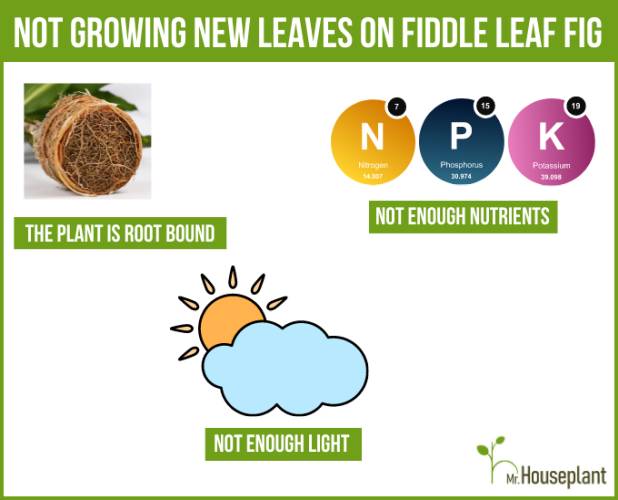
Three possible reasons that your plant isn't growing new leaves.
Water Spots On Fiddle Leaf Figs
Water spots on Fiddle Leaf Fig are caused by mineral deposits from hard water and salt deposits from fertilizer. While water spots are unsightly, they do not harm your Fiddle Leaf Fig.
To remove the water spots, whipe your Fiddle Leaf Fig with a mixture of soap and water and rinse with distilled water. To learn more about water spots on Ficus Lyrata, how to remove them and how to prevent them, check out the linked blog post.

White spots (water spots) on Fiddle Leaf Fig leaves
Fiddle Leaf Fig Edema
Fiddle Leaf Fig edema (also spelled as oedema) is a symptom of moisture stress. When plant roots absorb more water than the leaves can transpire, this leads to pressure building up in the leaf cells until they burst. You will notice the burst cells as small red spots on the leaves.
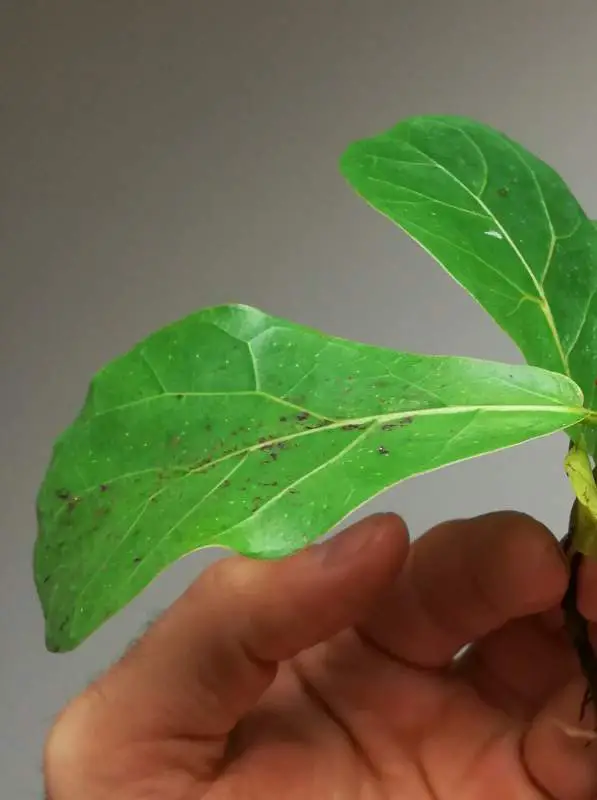
Small brown and red spots on Fiddle Leaf Fig leaves
You cannot remove edema from a Fiddle Leaf Fig, but as the leaf matures, the red spots from edema will become less visible. To learn more about Ficus Lyrata edema, check out the linked blog post.
Here is the video about Fiddle Leaf Fig edema:
Mushrooms
Mushrooms in Fiddle Leaf Fig soil are caused by a fungus, in most cases, Leucocoprinus Birnbaumii (Lepiota Lutea). Mushrooms are not harmful to Fiddle Leaf Figs, so you don’t have to remove them for the sake of the plant. To remove the mushrooms, pull them out of the soil. Low light, no direct sunlight and damp soil make the perfect environment for mushrooms to grow.
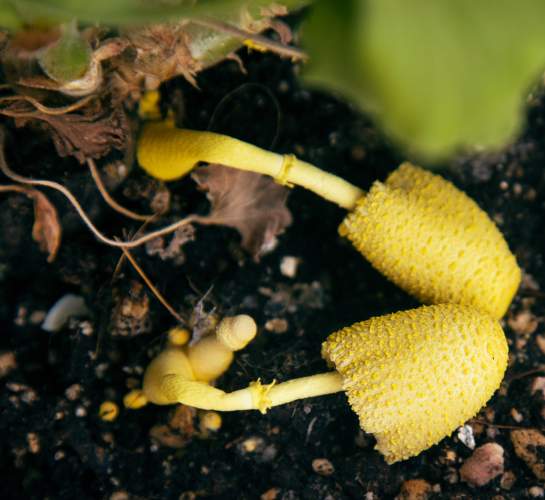
In the Fiddle Leaf Fig soil may grow yellow mushrooms
To prevent mushrooms from growing, provide Fiddle Leaf Fig with a lot of direct sunlight, good air circulation, a sterile potting mix and a proper watering routine. To learn more about mushrooms in Ficus Lyrata soil, check out the linked blog post.
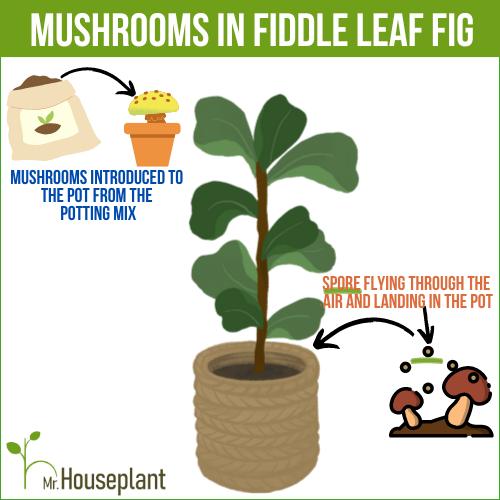
There are two sources that mushrooms can appear from: A soil mix that you pour into the pot and a spore coming through the air directly from a mushroom
Fiddle Leaf Fig Pests
Some of the common Fiddle Leaf Fig pests are spider mites, fungus gnats, mealy bugs, scales and thrips. Spider mites are the most common and the easiest to deal with. Washing the leaves with water, insecticidal soaps, or neem oil are good solutions.
Mealybugs are next in line. You can get rid of mealybugs by spot treatment with isopropyl alcohol. Insecticidal soaps, horticultural oil, or neem oil can also be applied directly on mealybugs.
Fungus gnats do not harm Fiddle Leaf Figs. To get rid of them use Mosquito Bits and yellow sticky notes, or a systemic insecticide. To learn more about all Fiddle Leaf Fig pests, how to recognize them and how to treat Ficus Lyrata against them, check out the linked blog post.
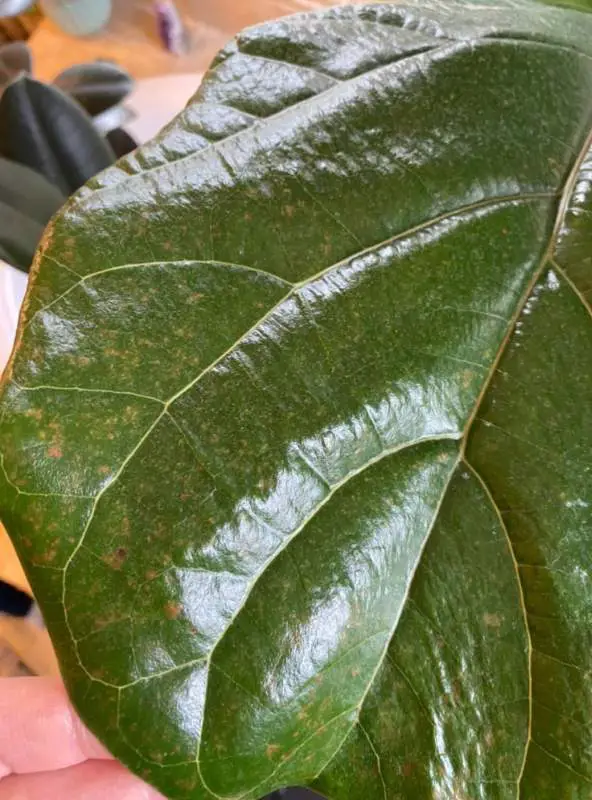
Pest damage of Ficus Lyrata leaf
Check out the natural methods to get rid of pests:
FAQ
Why Is My Fiddle Leaf Fig Not Growing?
Your Fiddle Leaf Fig isn’t growing because of one of the following reasons: lack of nutrients, an insufficient amount of light, or because the plant is root bound. Repot your Fig each year to provide fresh soil and ensure the plant gets all necessary nutrients. Use an airy, well-draining potting soil mix. Go for a 1-inch larger pot every year when repotting. To provide a good amount of light, keep your plant in front of the brightest window, ideally with some direct sun.
How Do You Fix A Lopsided Fiddle Leaf Fig?
To fix a lopsided Fiddle Leaf Fig, rotate the plant regularly. It will let the Fiddle tree get light from all sides and grow symmetrically. Pruning is a great way to maintain the shape and prevent the plant from getting lopsided.
Yours Truly,

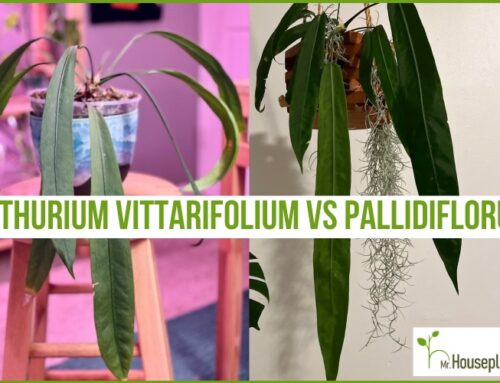
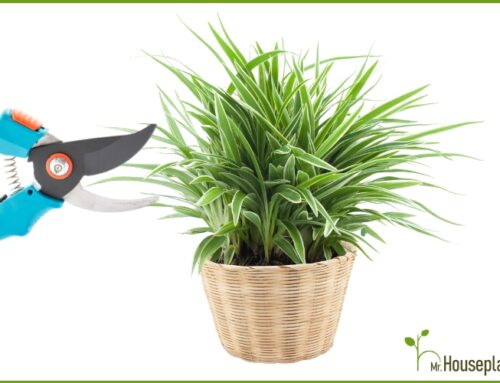
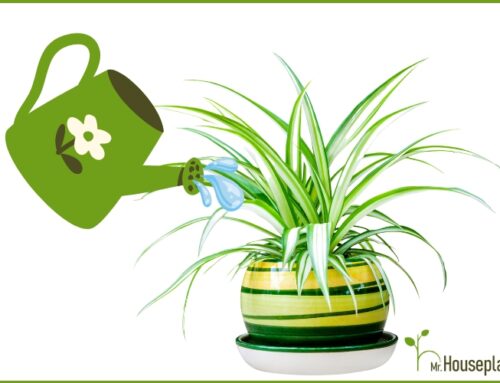

After move from inland to beach, leaves 1st fell off. Moved to high indirect light area, & section of leaves on part of plant are severely wilted & limp for a several days, but remain very green with no brown, with stem areas limp. Help
Hi Natalie, diagnosing plant problems requires a bit more information and also photos of the problem. There could be several reasons for the issues you are describing, but I would need to see some photos before I can reply.
You can send me the photos through this link: https://www.mrhouseplant.com/recommends/plant-questions/. Please send me the photos of: 1) the leaves and stems experiencing the problem 2) the whole plant including the pot 3) the room where the plant is located (make sure the window that is providing the light is in the photo).
I will also need the following information:
1) how long have you had the plant
2) how do you determine that the plant needs water
3) how do you water the plant, describe the whole process
Looking forward to hearing from you 🙂